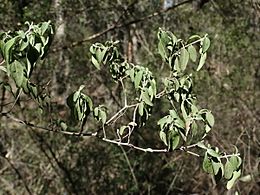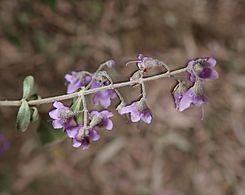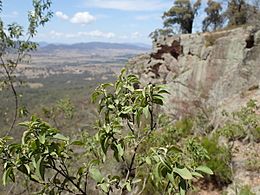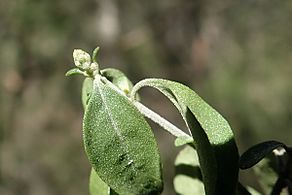Singleton mint bush facts for kids
Quick facts for kids Singleton mint bush |
|
|---|---|
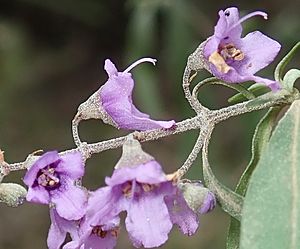 |
|
| Conservation status | |
| Scientific classification | |
| Genus: |
Prostanthera
|
| Species: |
cineolifera
|
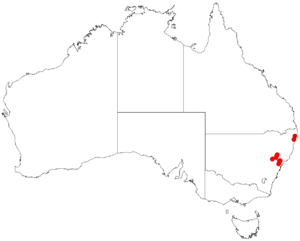 |
|
| Occurrence data from AVH | |
The Prostanthera cineolifera, also known as the Singleton mint bush, is a special flowering plant. It belongs to the Lamiaceae family, which includes mint plants! This shrub grows only in eastern New South Wales, Australia. It has branches with tiny hairs, leaves shaped like narrow eggs, and beautiful pale purple to dark purple flowers. These flowers grow in groups at the ends of its branches.
Contents
What the Singleton Mint Bush Looks Like
The Singleton mint bush is a shrub that stands upright. It can grow to be about 1 to 4 meters tall. Its stems are hairy and have tiny bumps called glands, which might feel a bit sticky. This plant also has a strong, minty smell!
Its leaves are light green and shaped like narrow eggs. They are about 12 to 50 millimeters long and 4 to 12 millimeters wide. Each leaf has a small stalk, called a petiole, that connects it to the stem. This stalk is usually 2 to 7 millimeters long.
The flowers grow in clusters at the tips of the branches. They have small leaf-like parts called bracteoles, which are about 1 to 2 millimeters long and fall off as the flowers open. The sepals, which are like small leaves that protect the flower bud, are 3 to 4 millimeters long. They form a tube that is 2 to 2.5 millimeters long.
The petals of the flowers are pale mauve to dark purple-mauve. They are 8 to 12 millimeters long and are joined together to form a tube. The inside of this tube is usually a darker color. You can see these lovely flowers blooming from September to October.
Naming the Singleton Mint Bush
The Singleton mint bush was first officially named in 1912. Two scientists, Richard Thomas Baker and Henry George Smith, described it in a scientific journal. They gave it the name Prostanthera cineolifera.
Where the Singleton Mint Bush Lives
You can find the Singleton mint bush in a few different places in New South Wales. It has been seen near Apsley Falls (which is close to Walcha) and in various spots in the Hunter Valley. This plant likes to grow in forests and woodlands, especially on exposed ridges where it can get plenty of sunlight.
Protecting the Singleton Mint Bush
The Singleton mint bush is considered a "vulnerable" plant. This means it needs our help to survive! Both the Australian Government and the New South Wales Government have laws to protect it.
The main reasons this plant is vulnerable are:
- Fire problems: Fires that happen too often, or not often enough, can harm the plant's natural growth cycle.
- Small population: There aren't many of these plants left, which makes them more at risk.
By understanding these threats, we can work to protect this unique mint bush for the future.



